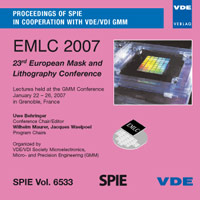Achieving Mask Order Processing Automation, Interoperability and Standardization based on P10
Konferenz: EMLC 2007 - 23rd European Mask and Lithography Conference
22.01.2007 - 26.01.2007 in Grenoble, France
Tagungsband: EMLC 2007
Seiten: 9Sprache: EnglischTyp: PDF
Persönliche VDE-Mitglieder erhalten auf diesen Artikel 10% Rabatt
Autoren:
Rodriguez, B. (De Clercq Engineering BVBA, Paepestraat, 84, 9260 Wichelen, Belgium)
Filies, O. (Infineon Technologies AG, Am Campeon 1-12 85579 Neubiberg, Germany)
Sadran, D.; Tissier, Michel (Toppan Photomasks France SAS, 460, avenue Victoire ZI, 13106 Rousset-Cedex, France)
Albin, D. (Atmel S.A., Atmel Rousset, Zone industrielle, 13106 Rousset-Cedex, France)
Stavroulakis, S.; Voyiatzis, E. (Photronics Hellas S.A., Lavrio Technological & Cultural Park - Lavrio Avenue P.O . Box 514. 19500 Lavrio, Attica, Greece)
Inhalt:
Last year the MUSCLE ("Masks through User’s Supply Chain: Leadership by Excellence") project was presented. Here is the project advancement. A key process in mask supply chain management is the exchange of technical information for ordering masks. This process is large, complex, company specific and error prone, and leads to longer cycle times and higher costs due to missing or wrong inputs. Its automation and standardization could produce significant benefits. We need to agree on the standard for mandatory and optional parameters, and also a common way to describe parameters when ordering. A system was created to improve the performance in terms of Key Performance Indicators (KPIs) such as cycle time and cost of production. This tool allows us to evaluate and measure the effect of factors, as well as the effect of implementing the improvements of the complete project. Next, a benchmark study and a gap analysis were performed. These studies show the feasibility of standardization, as there is a large overlap in requirements. We see that the SEMI P10 standard needs enhancements. A format supporting the standard is required, and XML offers the ability to describe P10 in a flexible way. Beyond using XML for P10, the semantics of the mask order should also be addressed. A system design and requirements for a reference implementation for a P10 based management system are presented, covering a mechanism for the evolution and for version management and a design for P10 editing and data validation.


